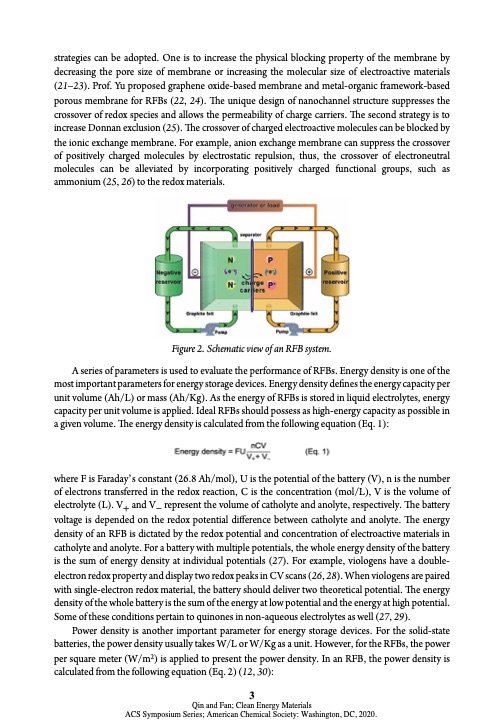
PDF Publication Title:
Text from PDF Page: 003
strategies can be adopted. One is to increase the physical blocking property of the membrane by decreasing the pore size of membrane or increasing the molecular size of electroactive materials (21–23). Prof. Yu proposed graphene oxide-based membrane and metal-organic framework-based porous membrane for RFBs (22, 24). The unique design of nanochannel structure suppresses the crossover of redox species and allows the permeability of charge carriers. The second strategy is to increase Donnan exclusion (25). The crossover of charged electroactive molecules can be blocked by the ionic exchange membrane. For example, anion exchange membrane can suppress the crossover of positively charged molecules by electrostatic repulsion, thus, the crossover of electroneutral molecules can be alleviated by incorporating positively charged functional groups, such as ammonium (25, 26) to the redox materials. Figure 2. Schematic view of an RFB system. A series of parameters is used to evaluate the performance of RFBs. Energy density is one of the most important parameters for energy storage devices. Energy density defines the energy capacity per unit volume (Ah/L) or mass (Ah/Kg). As the energy of RFBs is stored in liquid electrolytes, energy capacity per unit volume is applied. Ideal RFBs should possess as high-energy capacity as possible in a given volume. The energy density is calculated from the following equation (Eq. 1): where F is Faraday’s constant (26.8 Ah/mol), U is the potential of the battery (V), n is the number of electrons transferred in the redox reaction, C is the concentration (mol/L), V is the volume of electrolyte (L). V+ and V− represent the volume of catholyte and anolyte, respectively. The battery voltage is depended on the redox potential difference between catholyte and anolyte. The energy density of an RFB is dictated by the redox potential and concentration of electroactive materials in catholyte and anolyte. For a battery with multiple potentials, the whole energy density of the battery is the sum of energy density at individual potentials (27). For example, viologens have a double- electron redox property and display two redox peaks in CV scans (26, 28). When viologens are paired with single-electron redox material, the battery should deliver two theoretical potential. The energy density of the whole battery is the sum of the energy at low potential and the energy at high potential. Some of these conditions pertain to quinones in non-aqueous electrolytes as well (27, 29). Power density is another important parameter for energy storage devices. For the solid-state batteries, the power density usually takes W/L or W/Kg as a unit. However, for the RFBs, the power per square meter (W/m2) is applied to present the power density. In an RFB, the power density is calculated from the following equation (Eq. 2) (12, 30): 3 Qin and Fan; Clean Energy Materials ACS Symposium Series; American Chemical Society: Washington, DC, 2020.PDF Image | Electroactive Materials Next-Generation Redox Flow Batteries

PDF Search Title:
Electroactive Materials Next-Generation Redox Flow BatteriesOriginal File Name Searched:
bk-2020-1364.ch001.pdfDIY PDF Search: Google It | Yahoo | Bing
Salgenx Redox Flow Battery Technology: Salt water flow battery technology with low cost and great energy density that can be used for power storage and thermal storage. Let us de-risk your production using our license. Our aqueous flow battery is less cost than Tesla Megapack and available faster. Redox flow battery. No membrane needed like with Vanadium, or Bromine. Salgenx flow battery
| CONTACT TEL: 608-238-6001 Email: greg@salgenx.com | RSS | AMP |